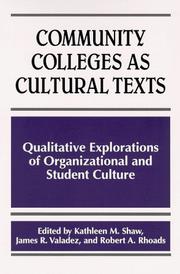Book
ISBN: 3031111249 3031111230 Year: 2022 Publisher: Cham, Switzerland : Springer International Publishing,
Abstract | Keywords | Export | Availability | Bookmark
 Loading...
Loading...Choose an application
- Reference Manager
- EndNote
- RefWorks (Direct export to RefWorks)
Minorities --- Education (Higher) --- Minority college students --- Education --- Minories --- Educació superior --- Estats Units d'Amèrica

ISBN: 079144290X Year: 1999 Publisher: Albany (N.Y.) : State university of New York press,
Abstract | Keywords | Export | Availability | Bookmark
 Loading...
Loading...Choose an application
- Reference Manager
- EndNote
- RefWorks (Direct export to RefWorks)
Community colleges --- Critical pedagogy --- Educational change --- Minority college students --- Multicultural education --- Administration. --- Sociological aspects.
Book
ISBN: 0841233640 Year: 2018 Publisher: Washington, DC : American Chemical Society,
Abstract | Keywords | Export | Availability | Bookmark
 Loading...
Loading...Choose an application
- Reference Manager
- EndNote
- RefWorks (Direct export to RefWorks)
Science --- Technology --- Engineering --- Mathematics --- Minority college students --- Dropouts --- Study and teaching (Higher) --- Prevention.
Book
ISBN: 9780230620681 Year: 2010 Publisher: Basingstoke Palgrave Macmillan
Abstract | Keywords | Export | Availability | Bookmark
 Loading...
Loading...Choose an application
- Reference Manager
- EndNote
- RefWorks (Direct export to RefWorks)
"In The Future of Diversity, distinguished academic leaders - heads of universities and foundations as well as faculty with valuable research and personal experience - discuss the next stage in the pursuit of democratic diversity and excellence on our campuses across the country. How can we make our universities more socially representative and open to all who wish to study? How can we create a campus culture that is more hospitable to a diverse student, staff, and faculty? What steps can we take to improve the university's relevance to our globalizing world? This volume assesses current attempts to create a positive and democratic campus culture and lays out some specific and general proposals for achieving greater success in the future"--Provided by publisher.
Cultural pluralism --- Education, Higher --- Minority college students --- Multicultural education --- Racism in higher education
Book
ISBN: 1610448545 9781610448543 9780871540010 0871540010 Year: 2015 Publisher: New York : Baltimore, Md. : Russell Sage Foundation, Project MUSE,
Abstract | Keywords | Export | Availability | Bookmark
 Loading...
Loading...Choose an application
- Reference Manager
- EndNote
- RefWorks (Direct export to RefWorks)
Book
Year: 2010 Publisher: Washington : U.S. G.P.O.,
Abstract | Keywords | Export | Availability | Bookmark
 Loading...
Loading...Choose an application
- Reference Manager
- EndNote
- RefWorks (Direct export to RefWorks)
Science --- Engineering --- Technology --- Mathematics --- Minority college students --- Minorities --- Study and teaching (Higher) --- Recruiting --- Education (Higher)
Book
ISBN: 1475833849 9781475833843 9781475833812 1475833822 9781475833829 1475833814 Year: 2017 Publisher: Lanham, [Maryland] : Rowman & Littlefield,
Abstract | Keywords | Export | Availability | Bookmark
 Loading...
Loading...Choose an application
- Reference Manager
- EndNote
- RefWorks (Direct export to RefWorks)
Diversity in the workplace --- Community colleges --- Minority college students --- Educational equalization --- Employees --- Recruiting --- Chief diversity officer
Book
ISBN: 9004396470 9789004396470 9789004396463 9789004396456 9004396454 Year: 2019 Publisher: Leiden ; Boston : Brill Sense,
Abstract | Keywords | Export | Availability | Bookmark
 Loading...
Loading...Choose an application
- Reference Manager
- EndNote
- RefWorks (Direct export to RefWorks)
Critical stories are more than just anecdotes or tales. They are narratives that raconter, or recount, the author’s own experiences, situating them in broader cultural contexts. Just as the autoethnographer situates the self in relation to the “others” of which the self is both a part and from which it is distinct, the critical storyteller situates his or her story of conflict in relation to the broader reality from which the conflict arises. The key is the reality that is being related and the perspective from which it is being shared. In Critical Storytelling in Millennial Times , marginalized, excluded, and oppressed people share insights from their liminality and help readers learn from their perspectives and experiences. Examples of stories in this volume range from undergraduate perspectives on financial aid for college students, to narratives on first-hand police brutality, to heartbreaking tales about addiction, bullying, and the child sex trade in Cambodia. Undergraduate authors relate their stories and pose important questions to the reader about inciting change for the future. Follow along in their journeys and learn what you can do to make a change in your own reality. Contributors are: Ben Brawner, Dwight Brown, Bryce Cherry, Kaytlin Jacoby, Jimmy Kruse, Dean Larrick, Bric Martin, Kara Niles, Claire Parrish, Grace Piper, Claire Prendergast, Alexsenia Ralat, Alec Reyes, Stephanie Simon, S. H. Suits, Katy Swift, Morgan Vogels, and Brittany Walsh.
College students --- Minority college students --- Women college students --- Generation Y. --- Generation Z. --- Social conditions. --- Attitudes.
Book
ISBN: 1003447678 1000981460 1000976203 1003447678 1579228178 Year: 2013 Publisher: Sterling, Virginia : Stylus,
Abstract | Keywords | Export | Availability | Bookmark
 Loading...
Loading...Choose an application
- Reference Manager
- EndNote
- RefWorks (Direct export to RefWorks)
This volume addresses the role of chief diversity officers as coordinating and integrating diversity leaders in higher education and other sectors. This book begins by delineating the evolution of the chief diversity officer role in the academy.
Educational equalization --- Minority college students --- Organizational change --- Universities and colleges --- Recruiting --- Employees. --- Chief diversity officer
Book
Year: 2017 Publisher: [Boston, Mass.] : University of Massachusetts Boston,
Abstract | Keywords | Export | Availability | Bookmark
 Loading...
Loading...Choose an application
- Reference Manager
- EndNote
- RefWorks (Direct export to RefWorks)
First-generation college students --- Low-income college students --- Minority college students --- Working class --- Social conditions.

 Search
Search Feedback
Feedback About UniCat
About UniCat  Help
Help News
News